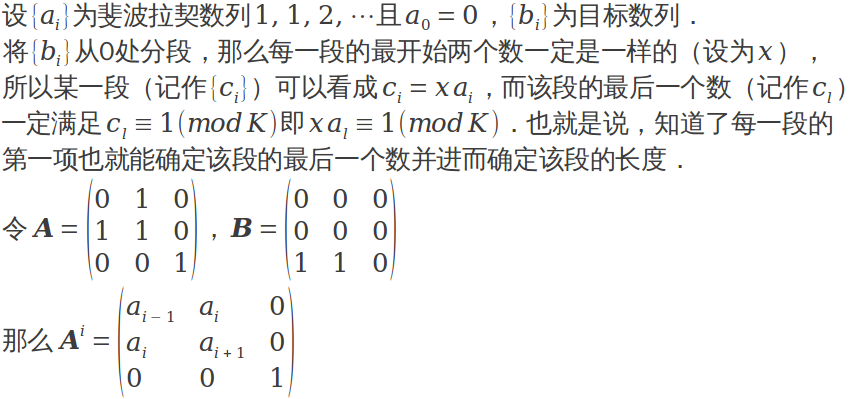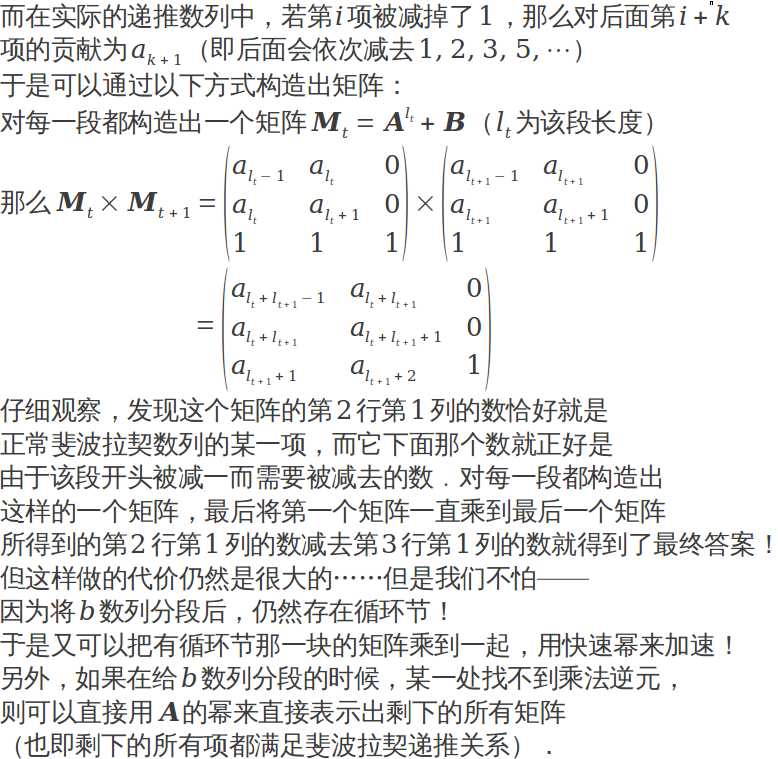Description 农夫栋栋近年收入不景气,正在他发愁如何能多赚点钱时,他听到隔壁的小朋友在讨论兔子繁殖的问题。 问题是这样的:第一个月初有一对刚出生的小兔子,经过两个月长大后,这对兔子从第三个月开始,每个月初生一对小兔子。新出生的小兔子生长两个月后又能每个月生出一对小兔子。问第n个月有多少只兔子? 聪明的你可能已经发现,第n个月的兔子数正好是第n个Fibonacci(斐波那契)数。栋栋不懂什么是Fibonacci数,但他也发现了规律:第i+2个月的兔子数等于第i个月的兔子数加上第i+1个月的兔子数。前几个月的兔子数依次为: 1 1 2 3 5 8 13 21 34 … 栋栋发现越到后面兔子数增长的越快,期待养兔子一定能赚大钱,于是栋栋在第一个月初买了一对小兔子开始饲养。 每天,栋栋都要给兔子们喂食,兔子们吃食时非常特别,总是每k对兔子围成一圈,最后剩下的不足k对的围成一圈,由于兔子特别害怕孤独,从第三个月开始,如果吃食时围成某一个圈的只有一对兔子,这对兔子就会很快死掉。 我们假设死去的总是刚出生的兔子,那么每个月的兔子数仍然是可以计算的。例如,当k=7时,前几个月的兔子数依次为: 1 1 2 3 5 7 12 19 31 49 80 … 给定n,你能帮助栋栋计算第n个月他有多少对兔子么?由于答案可能非常大,你只需要告诉栋栋第n个月的兔子对数除p的余数即可。 Input 输入一行,包含三个正整数n, k, p。 Output 输出一行,包含一个整数,表示栋栋第n个月的兔子对数除p的余数。 Sample Input 6 7 100 Sample Output 7 HINT 1<=N<=10^18 2<=K<=10^6 2<=P<=10^9


为了方便看,也给一段Libreoffice Math脚本,请用Libreoffice Math打开:
"设"lbrace a_i rbrace"为斐波拉契数列"1,` 1,` 2,` dotsaxis "且"a_0 `=` 0","
lbrace b_i rbrace"为目标数列."
newline
"将"lbrace b_i rbrace"从0处分段,那么每一段的最开始两个数一定是一样的(设为"x"),"
newline
"所以某一段(记作"lbrace c_i rbrace")可以看成"c_i `=` x a_i",而该段的最后一个数(记作"c_l")"
newline
"一定满足" c_l `equiv` 1 (mod K)"即"x a_l `equiv` 1 (mod K)".也就是说,知道了每一段的"
newline
"第一项也就能确定该段的最后一个数并进而确定该段的长度."
newline "令" bold
A `=` left(matrix
{
0 # 1 # 0 ##
1 # 1 # 0 ##
0 # 0 # 1
}right)"," bold
B `=` left(matrix
{
0 # 0 # 0 ##
0 # 0 # 0 ##
1 # 1 # 0
}right)
newline
"那么"{bold A}^i `=` left(alignl matrix
{
a_{i `-` 1} # a_i # 0 ##
a_i # a_{i `+` 1} # 0 ##
0 # 0 # 1
}right)
newline
"而在实际的递推数列中,若第"i"项被减掉了"1",那么对后面第"i `+` k newline
"项的贡献为"a_{k `+` 1}"(即后面会依次减去"1,` 2,` 3,` 5,` dotsaxis ")"
newline
"于是可以通过以下方式构造出矩阵:"
newline
"对每一段都构造出一个矩阵"{bold M}_t `=` {bold A}^{l_t} `+` bold B "("l_t"为该段长度)"
newline "那么"
{bold M}_t `times` {bold M}_{t `+` 1} `=` left(alignl matrix
{
a_{l_t `-` 1} # a_{l_t} # 0 ##
a_{l_t} # a_{l_t `+` 1} # 0 ##
1 # 1 # 1
}right) `times`
left(alignl matrix
{
a_{l_{t `+` 1} `-` 1} # a_{l_{t `+` 1}} # 0 ##
a_{l_{t `+` 1}} # a_{l_{t `+` 1} `+` 1} # 0 ##
1 # 1 # 1
}right)
newline alignl ~~~~~~~~~~~~~~~~~~~
`=` left(alignl matrix
{
a_{l_t `+` l_{t `+` 1} `-` 1} # a_{l_t `+` l_{t `+` 1}} # 0 ##
a_{l_t `+` l_{t `+` 1}} # a_{l_t `+` l_{t `+` 1} `+` 1} # 0 ##
a_{l_{t `+` 1} `+` 1} # a_{l_{t `+` 1} `+` 2} # 1
}right)
newline
"仔细观察,发现这个矩阵的第"2"行第"1"列的数恰好就是"
newline
"正常斐波拉契数列的某一项,而它下面那个数就正好是"
newline
"由于该段开头被减一而需要被减去的数﹒对每一段都构造出"
newline
"这样的一个矩阵,最后将第一个矩阵一直乘到最后一个矩阵"
newline
"所得到的第"2"行第"1"列的数减去第"3"行第"1"列的数就得到了最终答案!"
newline
"但这样做的代价仍然是很大的……但是我们不怕——"
newline
"因为将"b"数列分段后,仍然存在循环节!"
newline
"于是又可以把有循环节那一块的矩阵乘到一起,用快速幂来加速!"
newline
"另外,如果在给"b"数列分段的时候,某一处找不到乘法逆元,"
newline
"则可以直接用"bold A"的幂来直接表示出剩下的所有矩阵"
newline
"(也即剩下的所有项都满足斐波拉契递推关系)."
代码:
/************************************\
* @prob: NOI2011 兔农 *
* @auth: Wang Junji *
* @stat: Accepted. *
* @date: July. 1st, 2012 *
* @memo: 数论、欧拉定理、矩阵乘法 *
\************************************/
#include <cstdio>
#include <cstdlib>
#include <algorithm>
#include <cstring>
#include <string>
typedef long long int64;
const int maxK = 1000010;
struct Matrix
{
int ele[3][3]; static int Mod;
Matrix() {memset(ele, 0, sizeof ele);} /* Matrix */
Matrix(const Matrix& b) {*this = b;} /* Matrix */
Matrix& operator=(const Matrix& b)
{memcpy(ele, b.ele, sizeof ele); return *this;}
/* operator= */
int* const operator[](const int& Ind) {return ele[Ind];} /* operator[] */
const int* const operator[](const int& Ind) const {return ele[Ind];} /* operator[] */
Matrix& operator*=(const Matrix& b)
{
static Matrix res;
for (int i = 0; i < 3; ++i)
for (int j = 0; j < 3; ++j)
{
int64 tmp = 0;
for (int k = 0; k < 3; ++k)
tmp += (int64)ele[i][k] * b[k][j];
res[i][j] = tmp % Mod;
} /* for */
return *this = res;
} /* operator*= */
} matr[maxK], A, B, C;
int Fib[maxK << 3], Ind_Fib[maxK], Ind_Cyc[maxK], len[maxK], p, K, Matrix::Mod = 0;
int64 n;
Matrix pow(const Matrix& a, int64 n)
{
Matrix res, tmp(a);
res[0][0] = res[1][1] = res[2][2] = 1;
for (; n; n >>= 1, tmp *= tmp) if (n & 1) res *= tmp;
return res;
} /* pow */
int pow(int a, int64 n, int Mod)
{
int64 res = 1, tmp = a;
for (; n; n >>= 1, (tmp *= tmp) %= Mod) if (n & 1) (res *= tmp) %= Mod;
return res;
} /* pow */
int gcd(int n, int m)
{
for (int r; m; n = m, m = r) r = n % m;
return n;
} /* gcd */
int main()
{
freopen("rabbit.in" , "r", stdin );
freopen("rabbit.out", "w", stdout);
scanf("%lld%d%d", &n, &K, &p);
Matrix::Mod = p;
Fib[1] = Fib[2] = 1;
for (int i = 3; ; ++i)
{
Fib[i] = (Fib[i - 1] + Fib[i - 2]) % K;
if (!Ind_Fib[Fib[i]]) Ind_Fib[Fib[i]] = i;
if (Fib[i] == 1 && Fib[i - 1] == 1) break;
} /* for */
int tmp = K, mul_Inv = 1;
for (int i = 2; i * i <= tmp; ++i)
if (tmp % i == 0)
{
mul_Inv *= i - 1;
while ((tmp /= i) % i == 0) mul_Inv *= i;
} /* if */
if (tmp > 1) mul_Inv *= tmp - 1;
A[0][1] = A[1][0] = A[1][1] = A[2][2] = 1;
B[0][0] = B[1][1] = B[2][2] = 1;
C[0][0] = C[1][1] = C[2][2] = 1;
memset(Ind_Cyc, 0xff, sizeof Ind_Cyc);
int tot = 0, ths = 1, ans = 0; int64 totlen = 0;
for (; Ind_Cyc[ths] == -1; ++tot)
{
if (gcd(ths, K) > 1 || !Ind_Fib[pow(ths, mul_Inv - 1, K)])
{
for (int i = 0; i < tot; ++i) B *= matr[i];
B *= pow(A, n - totlen);
ans = ((B[1][0] - B[2][0]) % p + p) % p;
printf("%d\n", ans);
return 0;
} /* if */
Ind_Cyc[ths] = tot;
int nxt = pow(ths, mul_Inv - 1, K);
len[tot] = Ind_Fib[nxt];
if (n < totlen + len[tot])
{
for (int i = 0; i < tot; ++i) B *= matr[i];
B *= pow(A, n - totlen);
ans = ((B[1][0] - B[2][0]) % p + p) % p;
printf("%d\n", ans);
return 0;
} /* if */
totlen += len[tot];
matr[tot] = pow(A, len[tot]);
++matr[tot][2][0] %= p;
++matr[tot][2][1] %= p;
ths = ((int64)ths * Fib[len[tot] - 1]) % K;
} /* for */
int start = Ind_Cyc[ths];
for (int i = 0; i < start; ++i) B *= matr[i], n -= len[i];
totlen = 0;
for (int i = start; i < tot; ++i) C *= matr[i], totlen += len[i];
B *= pow(C, n / totlen);
n %= totlen, totlen = 0;
for (int i = start; i < tot; ++i)
{
if (n < totlen + len[i])
{
B *= pow(A, n - totlen);
ans = ((B[1][0] - B[2][0]) % p + p) % p;
printf("%d\n", ans);
return 0;
} /* if */
B *= matr[i];
totlen += len[i];
} /* for */
return 0;
} /* main */
本文章来自CSDN博客,转载请注明出处:http://blog.csdn.net/whjpji/article/details/7709301